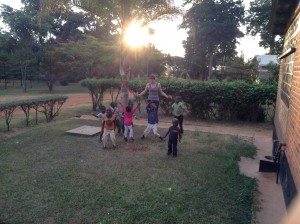You know that thing that Netflix or Kindle does that goes something along the lines of “If you enjoyed this title, here are some other suggestions that you might enjoy”?
I mean, it’s not like I’m super familiar with the message at the moment, as life in Malawi is Netflix-free. But you get my drift, I hope.
Well, what we’ve been figuring out in our free time (like this weekend) is that there are some things that you simply MUST do if you visit Namitando. Some of them are pretty obvious components of the experience, while others… not so easy to discover. So much like Netflix, pushing indie versions of your box box office favorites, I’m going to share some of my Namitando suggestions. Whether you’re a BTB intern hopeful, or are simply interested in learning a bit about village life, I hope this paints a better picture of our home.
***Note: EVERYTHING on this list is worth doing! I’m just pointing out the less obvious suggestions.
If you enjoyed: Visiting the Namitando market
You may also like: Taking a walk through local villages
Although the market gives some perspective on local life, it doesn’t tell you everything about life in rural Malawi. Especially given the relative privilege of living in houses near the hospital compound, it can be easy to lose sight of what ‘home’ means to our patients. Lucky for you, this one is pretty easy to remedy. Setting off in along any of the roads branching off before/after you reach the Namitando market will take you into small villages interspersed with maize fields and bush lands. Look around: the homes, the people, and the daily tasks all speak to public health conditions for the villagers. Just head out and prepare to get (somewhat) lost in pockets of village life that surround the hospital. Things to bring with you include a cell phone (in case you get too lost), a smile, and basic Chichewa vocabulary words (you need to say “Mwadzuka bwanji” to EVERYONE you meet!)


If you enjoyed: Getting groceries from the supermarket in Lilongwe
You may also like: Finding (almost) everything in the back market of Namitete and Namitando
The first time that we went to Lilongwe for groceries, we nearly broke the bank. This past time, we just topped off on a few imported products. The major difference between the two occurances is our familiarity with the local market system. The markets in Namitando and Namitete are both lined with small brick shops, usually advertising Airtel or TNM phone service and generally having a name like “God’s Favor Shop”. Although it’s easy to disregard these establishments, they actually present a fairly impressive variety of goods. After looking closer, we’ve managed to find everything from staples like bread and eggs to fancier items like toiletries, biscuits, and peanut butter. Some shops even sell chichenges (the colorful fabric that constitutes 75% of female fashions and tools in Malawi) at very reasonable prices! The main thing to keep in mind here are that it’s always okay to poke around and explore, whether that means doing a double take inside a small shop or going down the back alley to find a new part of the market.
If you enjoyed: Playing with kids around the Zitha house
You may also like: Teaching the kids something
A lot of the local kids are children of hospital workers or their friends from the village. I don’t like to brag, but I’ve developed quite the posse over the past few weeks- I’ve made it quite clear that I want to be friends, and after a hard day’s work, there really is nothing more fun than goofing off and acting like a kid for a few minutes (or hours). Because we’ve started to be better acquainted (read: I’m on first name terms, they only call me ‘azungu’ sometimes), I’ve started to take advantage of their friendliness. One day, I came home as usual and sat on the front porch of the guesthouse. Sure enough, not five minutes later I saw a10 little pairs of hands grip the wall and pull themselves up. This time, I was ready. I put on some music and started my best dancing (note: I’m using the term ‘best’ very loosely here). Chortling, the kids joined in. After I’d done the Chicken Dance, Macarena, Hand Jive, and Egyptian, I’d pretty much ran out of ideas. So I laced up my running shoes and started to do exercises. Although the sight of the crazy azungu doing crunches was even funnier than the dancing, the kids’ curiosity soon got the better of them. I showed them bicycle crunches, jumping jacks, suicide sprints, chair dips, planks, and tons of other fun exercises. Each time, I’d demonstrate, then my posse would immediately join in for a few sets. Although I didn’t necessarily think of it as anything more than a fun experience, a few days later I met one of my friends on the road to the hospital. He immediately dropped in the dirt and did bicycle crunches. Just goes to show that even demonstrating healthy habits can be a party!

If you enjoyed: Learning basic Chichewa phrases
You may also like: Getting Chichewa lessons
To live in a village or work at a hospital in Malawi, there are a few key phrases that you simply have to know:
good morning, good afternoon, how are you, have a good day, what’s your name, how much does it cost, your baby is cute (1), etc.
With your Malawian friends, however, you need a completely different vocabulary: Are you tired? What’s up? I’m confused, Do you like to dance?
You know, typical friendship stuff.
Having each of these vocabularies is pretty important, but you develop them in drastically different ways. For the former, it will suffice to skim past intern blogs, run some Google searches, and maybe pick up a trusty Chichewa 101 book (2). For the latter, you need to dig a little deeper. Sometimes that means asking a friend how to say something that’s relevant to the situation. Other times, it means taking advantage of some free time and trading snacks for Chichewa lessons at the hospital cafeteria or in the Zitha House kitchen.
Having started to develop the latter Chichewa vocabulary a little later, I’m still finding it to be tremendously helpful. Learning someone’s language is a great way to become a part of their world, even if you can only string together a maximum of 3 words. It’s the effort that supports the development of a relationship.

If you enjoyed: Going to mass at the Catholic church
You may also like: Going to mass at the Catholic church… in a chitenge!
I bought my first chitenge last week (!!!) and have been itching for the opportunity to wear it. However, my enthusiasm has been tempered by the knowledge that it’s very much a cultural symbol, and wearing it with respect is of utmost importance. For example, wearing a chichenge to work or the supermarket= pretentious foreigner.
At church, however, the chichenge reigns with sartorial ubiquity. As God’s house, the church is the place in Namitando that likely has the greatest respect for tradition and modesty. As such, putting a chichenge over my dress was not viewed as inappropriate. Rather, a Malawian friend told me that wearing a chichenge was sending the message that I love Malawi and appreciate its culture; that I respect its traditions and desire unity with the community of believers at the church. He told me it was a sign of loyalty.
Well, I’m not entirely sure if that’s all true, but I believe that my chichenge-wearing was well received. I definitely had more Chichewa conversations before and after the service, and I shook a TON of hands during the sharing of the peace. I was also a definite plus that chichenges are gorgeous and fairly comfy (when you can keep it wrapped tightly enough to stay put).


(1). I’m not a creep, I promise! When you pass mothers carrying their children almost CONSTANTLY in the hospital, it becomes a better alternative than just smiling at their kid.
(2). Neither BTB nor I is being paid to endorse Chichewa 101. It’s just the only Chichewa book on Amazon at the moment.